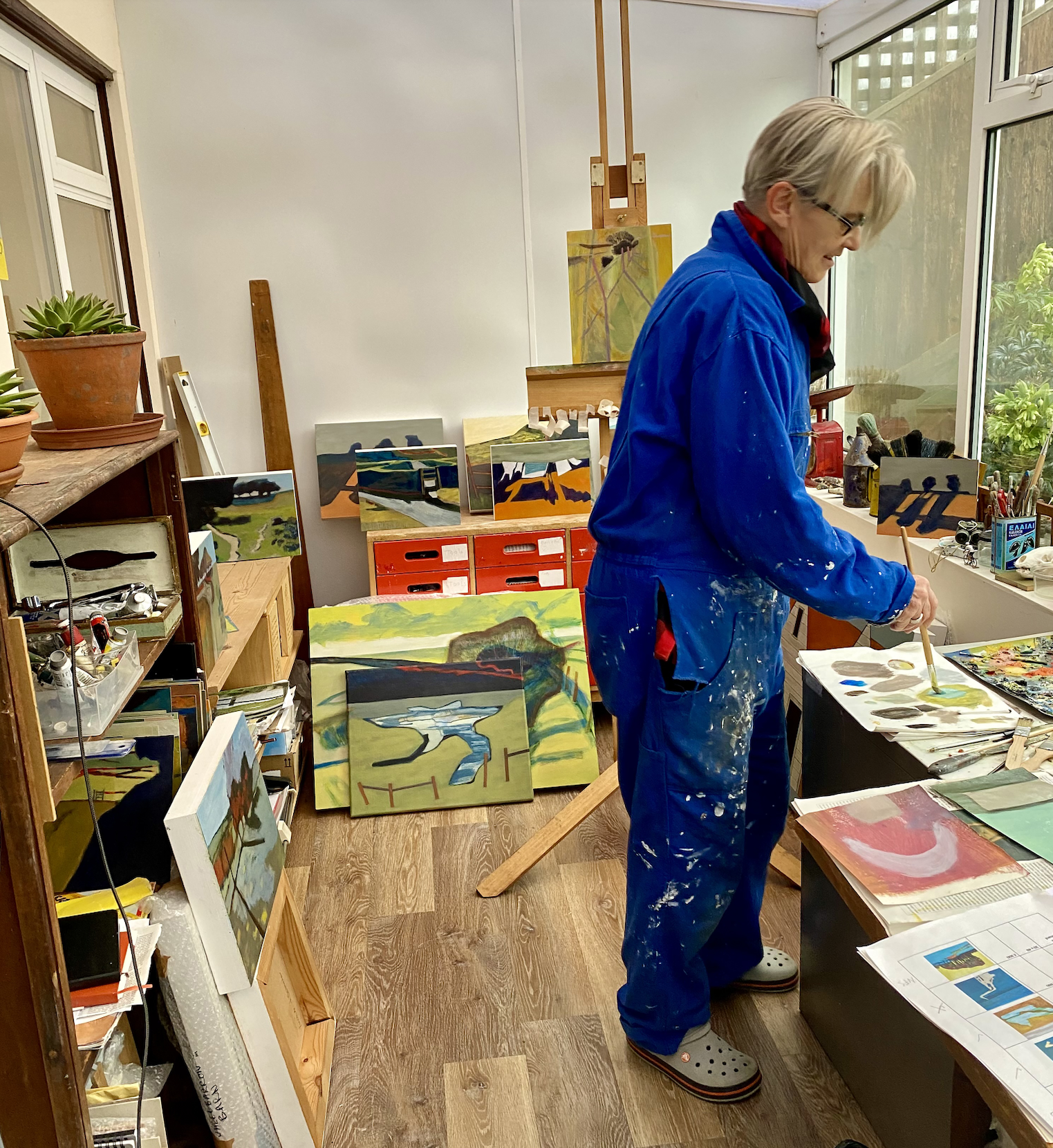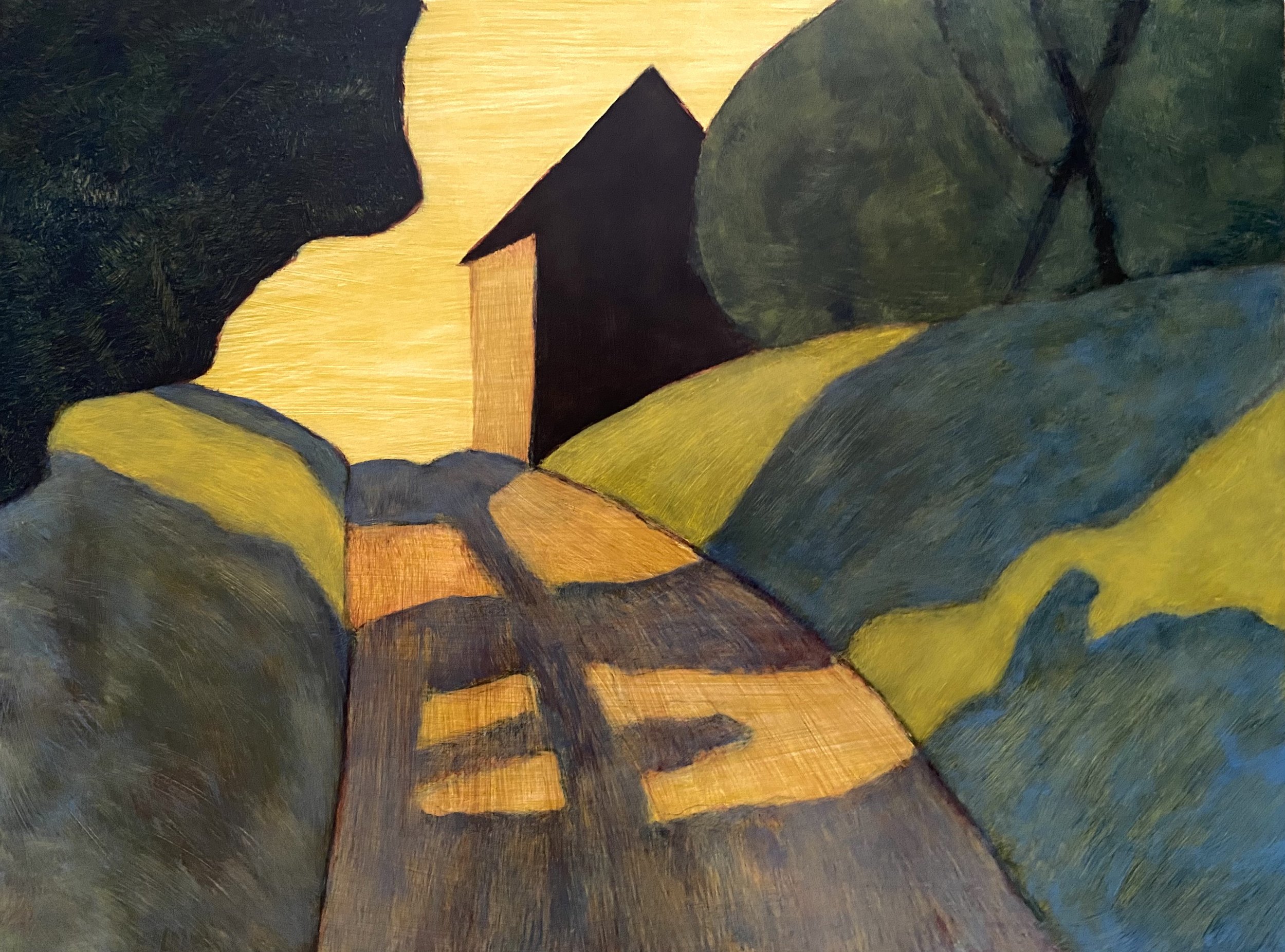Lucinda Oestreicher
In our latest exhibition A Moment In Time Catherine Knight and Lucinda Oestreicher capture natural landscapes distilled in time.
Lucinda Oestreicher’s current work is an embodied conversation with the landscape of East Sussex. She encounters this place through the rhythm of walking, pausing as she becomes aware of a particular configuration of shapes as they align and freeze in a moment in time.
We spoke to Lucinda in the lead up to her exhibition at Weald Contemporary to find out more…..
Lucinda, would you begin by telling us a bit about yourself?
Lucinda: I grew up in London and now work in London and East Sussex. In the last few years my work has been influenced by my passion for walking and now walking has become an essential part of my research for painting.
You studied painting at Bath Spa University in 1979, at that time the course had been moved out of the town and into the village of Corsham, you remember this time fondly, describing it as an ‘idyllic’ place to study. Please can you tell us about your time there?
Lucinda: I chose to go to art college at what was Bath Academy of Art - based in Corsham, because of it’s reputation and because it was deep in the countryside of Wiltshire. It was a tiny college, only 100 students over the 3 years in Fine Art, Graphics and Ceramics. As students we lived in old stone cottages in the hills and valleys near the college, sometimes with an outside bathroom. It was an idyllic life to be in the middle of nowhere but have the sustenance and community of art college life. I ran the Film club there and projected 16mm films of obscure works from the bfi archive catalogue in the old barn. Some of us also spent time at Greenham Common Women’s Peace Camp to protest against the cruise missiles stored there. From there I went to Central School of Art on the Postgraduate Printmaking course, while running the screen printing studio back in Corsham as the technician. I went to the Slade as a Postgraduate where I experimented with film and video as well as printmaking. Since the Slade I have returned to painting but am still inspired by film and use photography as a tool for composition and research.
How did you come to teach yourself?
Lucinda: I didn’t get to teaching until my late 40’s, I was living as an artist and running a decorating business on the side. I gave this up to start working in the painting department at the City Lit adult education college in Holborn. I really enjoyed developing courses such as ‘Ways into Abstract Painting’ and ‘Extended Drawing for Artists and Makers’ to allow the students to experiment hands on with different aspects of contemporary painting practices. Teaching really changed my own work as I found that creating courses for students made me unpick my own approaches to painting and re-think my practice. I have now been teaching there for 18 years and still enjoy teaching one day a week with my dedicated artist/ students on the Contemporary Painting Studio course.
You had an interesting childhood, encouraged to be free and creative, could you tell us more about life growing up?
Lucinda: I grew up in London in big family with four brothers, one half-sister and 2 step sisters. We were quite a big gang of unruly, scruffy kids and we loved to play football in the Islington streets and rampage around Hampstead Heath building dens. We lived in ramshackle houses in what was at the time called a bohemian lifestyle, with no conventional rules. My mother, Maggie Evans, was an artist who came from Wigan to go to the Slade in the 1950’s. She escaped from quite a repressive background where she didn’t fit in and completely created her own way of life in London. Her contemporaries at the Slade were David Storey, Paula Rego, Victor Willing, Anne Norman and Lucien Freud among others. She made our childhood full of colour and always encouraged us to be creative and resourceful as we didn’t have much money. My father was American and used to having the great outdoors to explore. He would take us out into the countryside at weekends to stay in remote cottages, or camp wild by rivers and cook on an open fire, which gave me a great love of being outdoors.
What is it about the Sussex countryside that keeps you returning to it as a subject matter?
Lucinda: When I was a child we used to stay at this tiny cottage near Glynde, Lewes which had no electricity. My stepfather hand-printed wallpaper for Peggy Angus who rented the cottage from Dick the Farmer. It was a magical place to be in and discover the Downs, particularly the Dewpond; a great dip in the ridge of hills, like an amphitheatre, full of space and air and the sound of larks. There is a special chalky light here and always huge skyscapes and wild wind. In the painting ‘Furlongs’ this is the view from Firle Beacon – seeing the cottage from far above, over 50 years later. Like looking down at my past from very far away. Now I spend as much time as possible here in the Downs following the chalk footpaths that wind amongst the hills. It is the height of these hills, and the far reaching views that give a feeling of flying above the flat plains that I find compelling.
The fact that it is a farmed landscape and there are traces of human intervention going back in time is also interesting to me, this isn’t a remote detached mountain wilderness. I love that mixture of wildness and ordinary domesticity in the turn of a footpath, the old stile or gatepost, and yet it’s possible to be quite alone in the wildness of the elements.
Could you speak a little about the paintings included in your current exhibition at Weald Contemporary with Catherine Knight ‘A Moment in Time’
Lucinda: The works in this exhibition span from 2018 – 2024.
During this time especially because of lockdown I was able to spend more time in the countryside and walking the same paths repeatedly made me look at moments and places in a deeper way. Many of them are from the area around Winchelsea in East Sussex, and the later ones come out of exploring the footpaths of the South Downs.
Around Winchelsea the Military Canal, the shingle levels of Rye Harbour and Winchelsea Beach, with it’s gravel pits changing shape with every storm and downpour became exciting forms. Now I’m getting to know the contours and atmospheres of local walks here in the Downs, it takes some time of repeated walking for me to be able to absorb and put this landscape into my work. Some of the paintings refer to both areas eg Red Trees which started as a Winchelsea landscape but has now merged with a windswept Downland walk.
My current paintings are a response to the visual and physical experience of exploring these landscapes. Walking through the same local places in all seasons, seeing them in motion, from the rhythm of a walk, then stopping when a particular configuration of shapes aligns and freezing that moment in time in a photograph or drawing, to be referenced back in the studio.
In the studio the process of painting takes over and images evolve through reworking, erasure and overpainting. I’m interested in the balance between what needs to be made explicit and the power of absence.
Shadows and reflections change in shape and density at different times of day and season. In the paintings they become solid forms, as important as any other objects. The fences and field boundaries are dynamic dividing lines carving up the space on the painting’s surface. Tracing the same paths over time a painting may hold within it numerous moments. Images of different walks and memories of engagement with specific places overlap. These moments of repetition and identification co-exist, overlap and interrupt in conversation with each other.
This conversation is about being with and within the landscape. I get to know the sense of a place by walking through it, then working with it over time in the studio. This changes the place next time I come across it – I experience a sense of recognition and special relationship, like meeting an old and familiar friend.
What are you reading at the moment?
Lucinda: Books and films are really important to me and influence my work in the same way that other artists do. Some of these are – artists Prunella Clough, Keith Vaughan, Susan Absalom, writers Nan Shepherd, Janet Frame, Edward Thomas, William Carlos Williams and Jane Bowles. The films of Werner Herzog and Jane Campion, and the early films of Wim Wenders. At the moment I’m reading Jean Rhys – her biography by Miranda Sawyer and her collected works. I can’t believe how modern her work feels, how ‘in the moment’ yet she was writing 100 years ago.
As you may know, it is essential that we conclude with a studio playlist! Please would you let me have a 5-10 track studio playlist?
Lucinda:
S Bach – All his work but at the moment the Cello suites and The Chaconde - Partita in D minor and Chorale
PJ Harvey – White Chalk
The Cure – The Forest
The Raincoats - Odyshape
David Bowie – Hunky Dory
Van Morrison – Veedon Fleece





